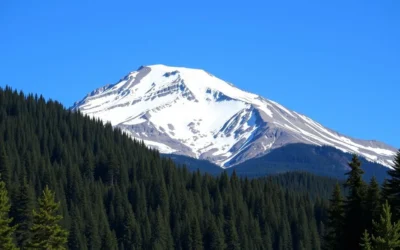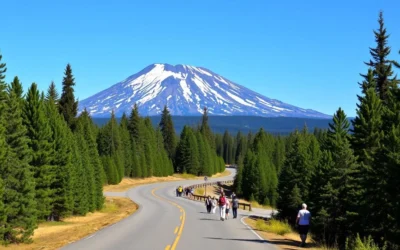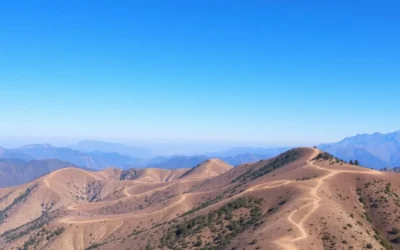Did you know that Monterey was California’s capital for over 70 years before statehood? This historic park preserves the very buildings where Spanish, Mexican, and American leaders once governed. Monterey State Historic Park offers a fascinating glimpse into California’s past through its collection of historic houses and buildings that played pivotal roles in the region’s heritage. As you explore this living museum, you’ll walk the same paths as early settlers, traders, and government officials who shaped the Golden State’s destiny.
Getting There & Planning Your Journey
Monterey State Historic Park is centrally located in downtown Monterey, making it easily accessible for visitors. The park’s historic buildings are scattered throughout the downtown area, with many concentrated around Custom House Plaza.
Closest Airports
- Monterey Regional Airport (MRY) – Just 10 minutes away by car
- San Jose International Airport (SJC) – Approximately 120 km (75 miles) north
- San Francisco International Airport (SFO) – About 160 km (100 miles) north
If you’re flying in from out of state or internationally, you’ll find more flight options to San Jose or San Francisco, followed by a scenic drive down the coast to Monterey.

Driving Directions
The park is easily accessible by car, with several parking options nearby:
- From Highway 1, take the Monterey exit and follow signs to downtown
- Public parking is available at the Waterfront Parking Lot near Fisherman’s Wharf
- Additional parking can be found at the Portola Hotel & Spa parking garage
Best Time to Visit Monterey State Historic Park
Timing your visit right can make a significant difference in your experience at Monterey State Historic Park. The park is open year-round, but certain seasons offer distinct advantages.
Recommended Times to Visit
- April to October – Mild temperatures and less fog
- Spring (April-May) – Wildflowers bloom and fewer crowds
- Weekday mornings – For the most peaceful experience
- Fall (September-October) – Pleasant weather and thinner crowds
Times to Avoid
- November to March – Rainy season with cooler temperatures
- Summer weekends – Peak tourist season with larger crowds
- Holiday periods – Especially crowded during major holidays
Weather Tips
Monterey has a mild Mediterranean climate, but the coastal location means weather can change quickly. Average temperatures range from 10-15°C (50-60°F) in winter to 18-22°C (65-72°F) in summer. Bring layers as mornings can be foggy and cool, even in summer months. The famous “June Gloom” brings heavy fog, so early fall often offers the most consistently pleasant weather.
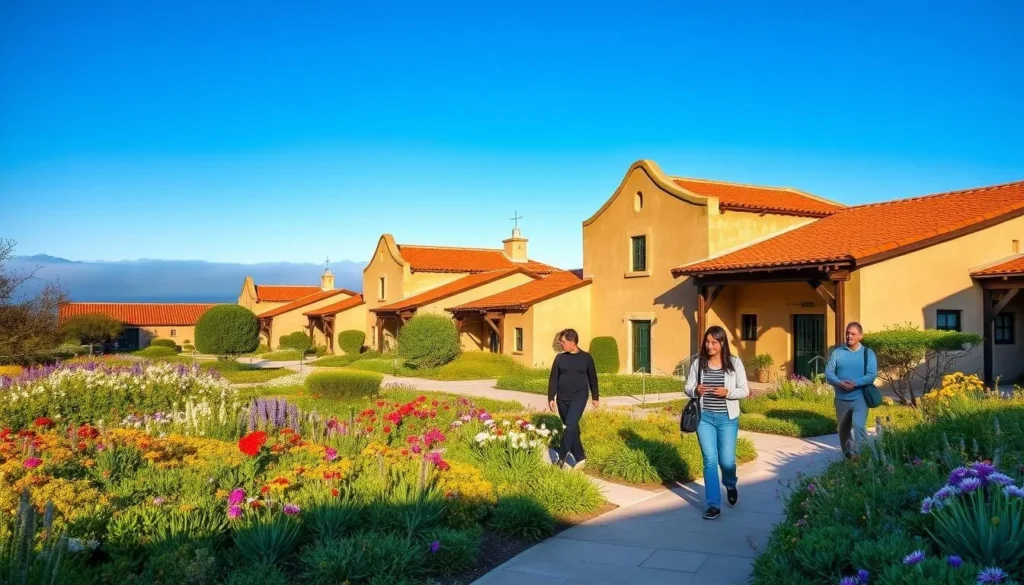
Local Tip: Spring mornings offer the perfect combination of blooming wildflowers, comfortable temperatures, and fewer crowds. If you visit during seal pupping season (April-May), you can also take a short trip to nearby Point Lobos to see harbor seal pups!
Getting Around Locally
Monterey State Historic Park consists of several historic buildings spread throughout downtown Monterey. The main sites are connected by the “Path of History,” marked by yellow tiles embedded in the sidewalk.
Walking the Path of History
The most authentic way to experience the park is on foot, following the 2-mile self-guided “Path of History” trail. This yellow-tiled path connects all the major historic buildings and provides a comprehensive tour of Old Monterey. Comfortable walking shoes are recommended as you’ll be covering some distance between buildings.
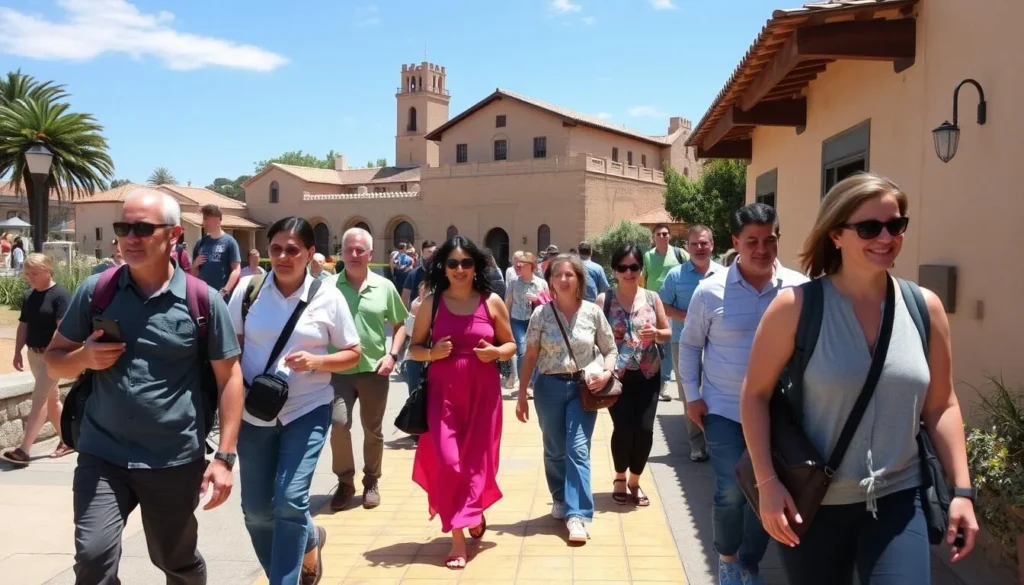
Guided Tours
For a more in-depth experience, guided walking tours are available and highly recommended. These tours are led by knowledgeable docents who bring the history to life with fascinating stories and insights not found on placards.
- Tours typically last about 1-1.5 hours
- Available on select days (check the official website for current schedule)
- Meeting point is usually at the Pacific House Museum
Enhance Your Visit with a Guided Experience
Discover the rich history of Monterey with expert guides.
Self-Guided Audio Tours
If you prefer to explore at your own pace but still want detailed information, self-guided audio tours are available. These allow you to learn about the historic sites while moving at your own speed.
Local Transportation
If you’re staying elsewhere in Monterey and need to reach the historic park:
- Monterey-Salinas Transit (MST) – Public buses serve the downtown area
- Monterey Trolley – Free seasonal trolley connecting major tourist spots
- Taxis and rideshare – Readily available throughout Monterey
Where to Stay
While there’s no lodging within Monterey State Historic Park itself, the surrounding area offers numerous accommodation options within walking distance of the historic sites.
Historic Luxury
For a truly immersive experience, consider staying at historic hotels near the park. The Portola Hotel & Spa is located right next to Custom House Plaza and offers upscale accommodations with easy access to all the historic sites.
Mid-Range Options
Several comfortable hotels and inns are available within walking distance of the park. Look for options in downtown Monterey or near Cannery Row for convenient access to both the historic park and other attractions.
Budget-Friendly Stays
More affordable accommodations can be found slightly further from the historic district. Pacific Grove and parts of Monterey away from the waterfront offer budget-friendly options with just a short drive to the park.
Find Your Perfect Stay in Monterey
Browse accommodations for every budget near Monterey State Historic Park.

Booking Tip: Accommodations in Monterey can fill up quickly during summer and holiday weekends. Book well in advance if you’re planning to visit during peak season.
Dining & Local Cuisine
While Monterey State Historic Park doesn’t have dining facilities within the historic buildings themselves, the surrounding area offers excellent options for experiencing local cuisine before or after your visit.
Nearby Dining Options
Fisherman’s Wharf
Just steps from the Custom House, Fisherman’s Wharf features numerous restaurants specializing in fresh seafood. Many offer outdoor seating with harbor views, perfect for enjoying clam chowder in sourdough bread bowls, a local specialty.
Alvarado Street
This main downtown thoroughfare near the historic park features a variety of dining options from casual cafes to upscale restaurants. You’ll find everything from Mexican cuisine (honoring Monterey’s heritage) to contemporary California fare.

Local Specialties to Try
- Monterey Bay Calamari – The local squid is renowned for its tenderness
- Clam Chowder – Especially in sourdough bread bowls
- Cioppino – Italian-American fish stew popular in the area
- Artichokes – Nearby Castroville is the “Artichoke Capital of the World”
- Local Wines – From nearby Carmel Valley and Santa Lucia Highlands
Picnic Options
If you prefer a picnic, you can purchase supplies at local delis or markets and enjoy your meal in the gardens near the Pacific House Museum or at nearby Custom House Plaza. This can be a delightful and budget-friendly option on pleasant days.
Dining Tip: Many restaurants offer “early bird” specials in the late afternoon before the dinner rush. This can be a great way to enjoy local cuisine at a more affordable price after your visit to the historic park.
Attractions, Sightseeing & Activities at Monterey State Historic Park
Monterey State Historic Park is a collection of historic buildings and sites that tell the story of California’s early development. Here are the must-see attractions within the park:
Pacific House Museum
This two-story adobe building serves as the park’s main museum. The upper floor houses a fantastic collection of California Native basket weaving (basketry), while the lower floor features exhibits on Monterey’s multicultural heritage. Don’t miss the beautiful Memory Garden behind the museum.
California First Theater
Built in 1846-47, this historic building was the site of the first theatrical performances in California. Though currently closed for renovation, the exterior is still worth viewing for its historical significance.
Custom House
California’s oldest government building and the state’s first designated historic landmark. This is where ships’ captains would declare their cargos during Mexican rule and early American period. The interior features period furnishings and exhibits about maritime trade.

More Historic Buildings to Explore
- Larkin House – Home of Thomas Larkin, the first and only U.S. Consul to Mexican Alta California
- Cooper-Molera Adobe – Recently restored complex with gardens, exhibits, and a bakery
- Colton Hall – Site of California’s first Constitutional Convention in 1849
- Old Whaling Station – Features exhibits on Monterey’s whaling industry history
- Casa Soberanes – Known as “The House of the Blue Gate,” showcasing early California lifestyle
Experience Monterey’s Rich History
Book a guided tour to make the most of your visit to these historic sites.
Self-Guided Exploration
Follow the yellow-tiled “Path of History” embedded in the sidewalks to discover all the key historic sites at your own pace. Free brochures with maps are available at the Pacific House Museum to guide your exploration.
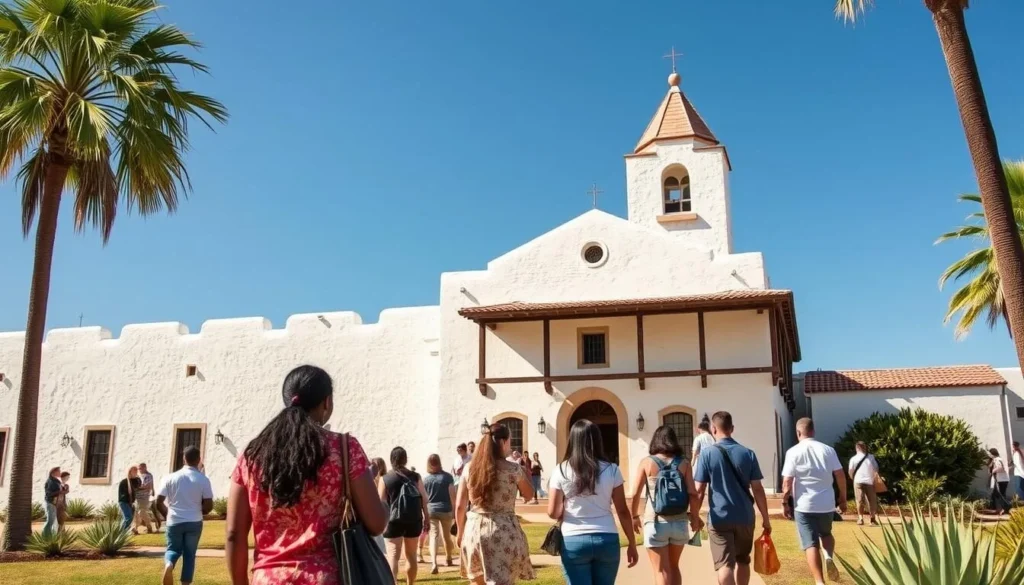
Museums, Cultural Spots & Festivals
Beyond the historic buildings themselves, Monterey State Historic Park offers several museums and cultural experiences that provide deeper insight into California’s rich heritage.
Museums Within the Park
- Pacific House Museum – The park’s main museum featuring exhibits on local history and Native American culture
- Custom House Museum – Displays about maritime trade and Monterey’s role as a port
- Colton Hall Museum – Exhibits on California’s constitutional history

Nearby Cultural Attractions
While exploring Monterey State Historic Park, consider visiting these nearby cultural sites:
- Monterey Museum of Art – Features California art and photography
- San Carlos Cathedral – California’s oldest continuously functioning church
- Salvador Dali Museum – Showcasing works by the famous surrealist artist
Annual Events & Festivals
The park hosts several cultural events throughout the year that bring history to life:
- Christmas in the Adobes – December event with candlelit tours of historic buildings
- History Fest – Educational programs and living history demonstrations
- Cultural Heritage Days – Celebrating the diverse cultures that shaped Monterey
Visitor Tip: Check the official California State Parks website for current event schedules and special exhibitions before your visit.
Living History Programs
On select days, the park offers living history demonstrations where costumed interpreters showcase traditional crafts, cooking methods, and daily life activities from Monterey’s past. These engaging programs provide a glimpse into how people lived during different periods of California’s history.
Sports, Nature & Outdoor Experiences
While Monterey State Historic Park itself focuses on historic buildings and cultural heritage, the surrounding area offers abundant opportunities to enjoy nature and outdoor activities.
Gardens and Green Spaces
Within the historic park, you’ll find several beautiful gardens worth exploring:
- Memory Garden – Behind the Pacific House, featuring native plants and a peaceful atmosphere
- Cooper-Molera Adobe Gardens – Historic gardens with period plantings
- Casa Soberanes Garden – Small but charming garden with coastal views

Nearby Outdoor Attractions
After exploring the historic park, consider these nearby natural attractions:
Monterey Bay Coastal Trail
This scenic 18-mile trail runs along the coastline and is perfect for walking, jogging, or cycling. The trail passes near the historic park and offers beautiful ocean views.
Point Lobos State Natural Reserve
Often called “the crown jewel of the State Park system,” Point Lobos is just a short drive south and offers spectacular hiking trails, wildlife viewing, and dramatic coastal scenery.
Water Activities
Monterey Bay provides opportunities for various water sports and activities:
- Kayaking – Paddle through the calm waters of Monterey Harbor near the historic park
- Whale Watching – Join boat tours departing from nearby Fisherman’s Wharf
- Stand-up Paddleboarding – Available for rent at nearby beaches

Explore Monterey’s Natural Beauty
Book outdoor activities to complement your historic park visit.
Safety, Etiquette & Local Customs
Visiting Monterey State Historic Park is generally very safe, but keeping these guidelines in mind will help ensure a pleasant experience for everyone.
Safety Considerations
- Historic Buildings – Watch your step in older buildings, which may have uneven floors or low doorways
- Sun Protection – Bring sunscreen, a hat, and water, especially during summer months
- Valuables – As with any tourist area, keep an eye on personal belongings
- Emergency Services – Park staff can assist with minor issues; dial 911 for emergencies
Visitor Etiquette
Help preserve these historic treasures for future generations by following these guidelines:
- Do not touch artifacts or exhibits unless specifically permitted
- Photography is generally allowed, but avoid using flash inside historic buildings
- Keep voices low inside museums and during guided tours
- Stay on designated paths and respect any closed or restricted areas
- Dispose of trash properly in provided receptacles
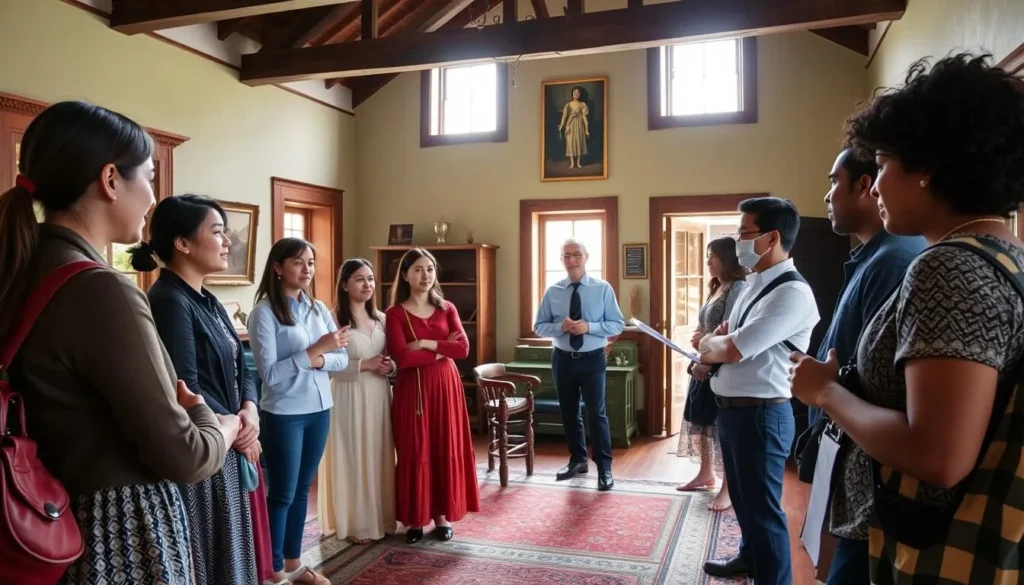
Accessibility Information
Many, but not all, of the historic buildings have been adapted for accessibility:
- The Pacific House Museum has wheelchair access to the first floor
- Some historic buildings have steps or narrow doorways that may present challenges
- Contact the park in advance for specific accessibility information
- Service animals are permitted in all buildings
Cultural Tip: Monterey celebrates its multicultural heritage, including Native American, Spanish, Mexican, and early American influences. Learning about these diverse contributions enhances appreciation of the historic sites.
Visitor Comments About Monterey State Historic Park
“Walking through these historic buildings felt like stepping back in time. The preservation is incredible! I especially loved the Pacific House Museum with its Native basket collection. Don’t miss the Memory Garden behind it—a perfect spot to rest between exploring the different sites.”
“The guided tours brought history to life in a way I’ve never experienced. Our guide Graham was knowledgeable and passionate about Monterey’s past. I learned so much about California’s early development and the different cultures that shaped this region. A must-visit for history lovers.”
“Perfect blend of education and beauty. The gardens between the historic buildings were absolutely stunning. I appreciated how the buildings are spread out throughout downtown—it gave us a chance to explore the whole area while following the yellow tile path. The Custom House was my favorite stop.”
Practical Travel Tips
Make the most of your visit to Monterey State Historic Park with these helpful tips:
Planning Your Visit
- Allow at least 2-3 hours to explore the main buildings
- Check the official website for current hours and tour schedules
- Download a map of the “Path of History” before your visit
- Consider a weekday visit to avoid weekend crowds
What to Bring
- Comfortable walking shoes for the 2-mile historic path
- Layers of clothing (Monterey weather can change quickly)
- Water bottle and sun protection
- Camera for capturing the historic architecture
Money-Saving Tips
- Many buildings can be viewed from outside for free
- The Pacific House Museum offers free admission
- Bring a picnic to enjoy in the gardens
- Look for combined tickets if visiting multiple attractions
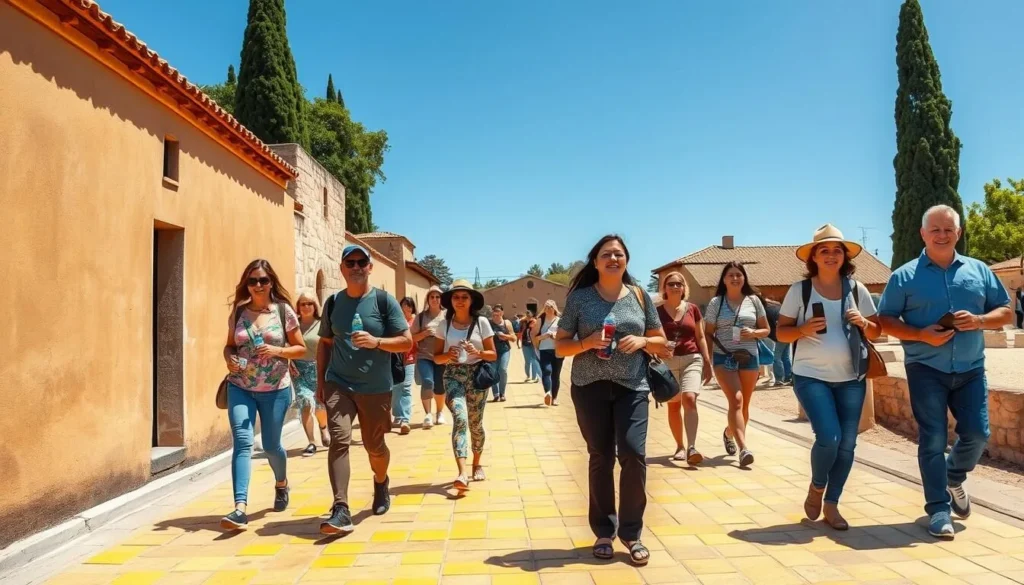
Combining with Other Attractions
Monterey State Historic Park is centrally located, making it easy to combine with other popular attractions:
- Monterey Bay Aquarium – About a 15-minute walk from the Custom House
- Cannery Row – Historic district with shops and restaurants
- Fisherman’s Wharf – Adjacent to the Custom House Plaza
- 17-Mile Drive – Scenic route through Pebble Beach, just a short drive away
Ready for a Monterey Adventure?
Book your complete trip including flights, accommodations, and activities.
Your Historic Adventure Awaits
Monterey State Historic Park offers a unique window into California’s fascinating past. As you walk the yellow-tiled path connecting these preserved buildings, you’ll gain a deeper appreciation for the diverse cultures and historical events that shaped the Golden State. From the adobe walls that witnessed California’s transition from Spanish colony to American state, to the beautiful gardens that provide peaceful respite, this living museum deserves a prominent place on your Monterey itinerary. Whether you’re a history enthusiast, architecture lover, or simply curious traveler, the stories preserved within these historic structures will enrich your understanding of California and leave you with lasting memories of Monterey’s significant role in American history.
The above is subject to change.
Check back often to TRAVEL.COM for the latest travel tips and deals.

